
When thinking of Lofoten, most people conjure up visions of huge granite walls and beautiful long multi-pitch routes; it doesn't instantly spring to mind as a bouldering venue. But where there is lots of rock there tend to be lots of boulders, and bouldering has become increasingly popular on Lofoten in recent years, both as a side-line to trad climbing and an activity in its own right.
Anyone who has been to Lofoten will know that the current development barely scratches the surface, and under every crag, up each valley and near every road are thousands of granite blocks and small walls of every size. The overwhelming scale of the potential can have a stifling effect on those looking for good problems since, until now, you never really knew where to start to find the best blocks.
"This book is all you need to locate the best bouldering spots (yet developed) on this climbing paradise, and get sufficient inspiration to want to go there - in other words, it succeeds admirably in a guidebook's main two criteria"
This is where Jonas Paulsson's new book 'A Comprehensive Guide to Bouldering in Lofoten' makes a welcome entrance. This A5 landscape book, with just over 300 pages, documents 752 problems on 24 different areas. Despite the list of helpers and contributors on the acknowledgements page, it does seem to ostensibly be a one-man effort in the main and Jonas' achievement is extremely impressive. To write, photography, produce and then publish a guidebook to a new area as your first solo major guidebook is no small task and deserves plaudits even before we examine the contents.
So what of the contents? Well for the short review, this book is all you need to locate the best bouldering spots (yet developed) on this climbing paradise and get sufficient inspiration to want to go there - in other words, it succeeds admirably in a guidebook's main two criteria.
For the longer review, let me start with the action photos. Jonas has managed to put together a stunning set of images capturing boulderers at dramatic moments and all set in the magnificently beautiful landscape of the area. I doubt if many bouldering books have had such inspiring photography. If there is a criticism it is that some of the photos look over Photoshopped, but overall there is little to complain about and there are a lot of great photos to choose from!
For the text information; the route descriptions are succinct, inspiring and useful. The approach text is clear and the maps easy to follow. Basically you have everything here to get you to the problems and know what you might find when you get there. The problems are listed on the same page as the photos they relate to and they follow the left-to-right convention both of which are pretty essential these days for any modern guidebook. I have a slight problem with listing the problems on single lines stretching across the full width of the A5 landscape pages. I think two columns would have worked better but it is still relatively clear although sometimes you need to double check that the box you are ticking corresponds to the right problem.
"One significant omission is quality ratings or stars for the problems. For a book which needs to appeal to visiting climbers more than locals, I found this quite a big thing to leave out"
On the subject of wide 'landscape orientation' A5 books - generally I am not a big fan. Having used a few over the years I have come to the conclusion that the simple soft-back cover used on most books isn't strong enough for a guidebook in this orientation - there is simply not enough spine to hold together the page mass properly and the books tend to fall apart more easily than portrait orientation A5 guides. However, in this case the book isn't too thick and it uses a stronger case binding with a soft cover, so it should last much better. The format also fits well with the photos which are mainly landscape so I can see why the book is this orientation. But do be aware that it is more fragile when you stuff it in your pad or bouldering bag.
One significant omission from the book is quality ratings or stars for the problems. For a book which needs to appeal to visiting climbers more than locals, I found this quite a big thing to leave out. I asked Jonas why he did this:
"I choose to omit quality ratings, mostly because many of the problems have had so few ascents so it's hard to make a fair rating. I also think quality ratings are a two-edged sword, they can draw traffic to some particular lines and cause them to wear down faster, while there might be other problems that are just as good, that may not have gotten a quality rating at all. But who knows, in a future second edition, where there might be more opinions on quality (not to mention grades!) out there I might change my mind and set up some kind of rating."
Fair enough but I strongly disagree. The argument about stars has been done before and my opinion has always been that liberal and effective use of stars actually helps spread the load more effectively; omitting stars just makes people go to areas that are easy to find, popular with others, well-chalked and obvious; it doesn't encourage people to explore. If, as he states, there may be equally good problems nearby that don't get stars, then give them stars!
Additionally, from a visitor's point of view, it is absolutely essential that you have some pointer of quality so that you can plan your limited time. Two weeks on Lofoten and you don't want to spend all your time on a load of ordinary problems when there is a magnificent area a little further away which you failed to find due to lack of information. A guidebook should 'guide' you in this respect. I would far rather have seen a set of star ratings that reflected Jonas's informed personal opinion than not had any stars at all.
Summary
Overall though this is an excellent book and most of my gripes are technical matters that I notice because I am a guidebook nerd. This is an extremely beautiful guidebook and an essential purchase if you are travelling to Lofoten to trad climb or just boulder. It can be purchased direct from the Lofoten Bouldering web site and is being distributed in the UK by Cordee (priced at £30) so it should also make the better specialist shops.
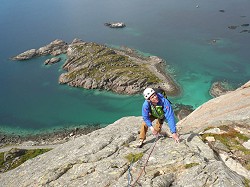
This summer Rockfax are working on a new guidebook to the trad climbing in Lofoten. The combination of Jonas Paulsson's Bouldering book and this new Rockfax, should give you everything you need to explore this magnificent climbing area.

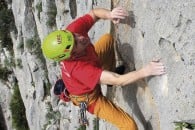



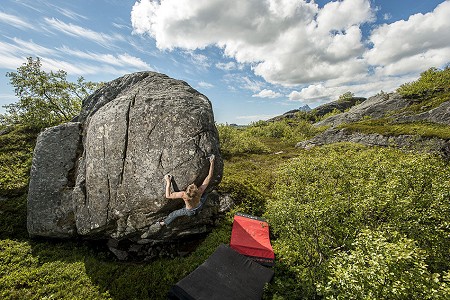
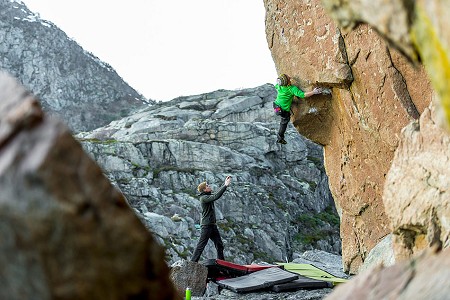
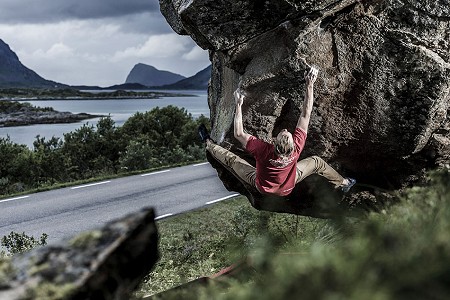











Comments